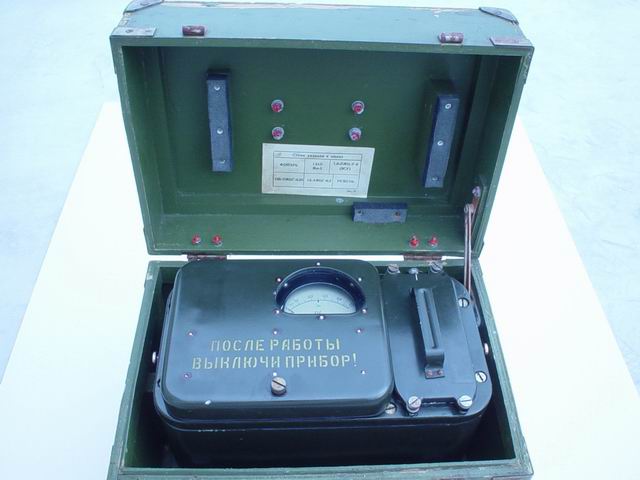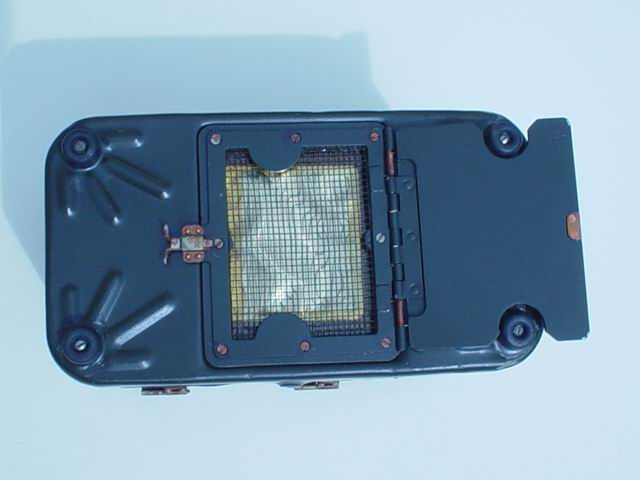Visitor's Gallery
Kurt's Page
Russian Military DP-1-B Roentgenmeter

DP-1-B in Shipping Container
Portable roentgenmeters are designed for measuring the radiation level in radioactivity contaminated areas.
Apart from this, with roentgenmeters it is possible to determine roughly the cumulative dose
of penetrating radiation received during passage through a contaminated area.
In principle, roentgenmeters are scaled ionization chambers. The existing types of field roentgenmeters
consist of a general unit in a metal casing. The basic parts of the instrument are the ionization chamber,
the ion current amplifier, a registering apparatus (scaled in r/hr), and a battery supply.
The ionization chamber is mounted in the back part of the general unit. Ionizing radiations penetrate into
the chamber through the window at the bottom of the instrument, which may be closed by an
aluminum cover. Cumulative beta and gamma radiations are registered when the cover is open,
and solely, i.e. not only to measure the the radiation in a contaminated site, but also to determine
the character of radioactive contamination.
Shipping Container dimensions are: 13½" Wide x 11¾" High x 9¼" Deep
Instrument dimensions: 11¼" Wide x 8" High x 6" Deep
Instrument weight approximately 6.5 lb. (less batteries)

DP-1-B in Shipping Container
This view is with the protective meter cover up.
The roentgenmeter makes it possible to measure radiation levels from 0.04 to 400 r/hr.
The full measuring range is divided into four subranges: the first from 0.02 to 0.4 r/hr,
the second from 0.2 to 4 r/hr, the third from 2 to 40 r/hr, and the fourth from 20 to 400 r/hr.
The Nameplate indicates this is a 1958 Model.

Inside View of Meter Cover
When measuring radiation levels, the instrument is carried on straps at a height of 0.7-1 meter from
the ground. When entering into a contaminated area, the switch regulating the type of work is turned
to the most sensitive subrange, and when the radiation level increases,
it is subsequently turned to greater subranges.
Field roentgenmeters make it possible to measure the radiation level of a contaminated site,
to determine the type of contamination, to determine the dose received while working
in a contaminated site, and to calculate the period during which it is possible to remain
safely in a contaminated area.

Bottom Of Unit
This view shows the beta shield covering the detector element.
The determination of the radiation level of gamma radiations is carried out when the cover of the entry
window of the ionization chamber is closed. The presence of beta-active contamination is determined
when the cover is open and the instrument shows higher values.

Bottom Of Unit
This view shows the beta shield open.
In order to measure the dose rate of beta radiation, two measurements are carried out,
when the lower cover of the instrument is closed and when the cover is closed, only that of gamma radiations.
The differences in the readings is the beta radiation dose rate, where it is necessary to take into
account the partial absorption of beta radiation by the walls of the ionizing chamber and to multiply
the difference in the readings of the instrument by the corrective factor K=10.

Battery Holder
Located on right side of unit and secured with 4 captive screws.
The roentgenmeter is fed by three batteries GB-111-No3, one battery BAS-G-13 and a dry element 2C.
The batteries are in a lateral compartment of the instrument and are connected to
the terminals of the panels according to the diagram drawn on the cover of the feed compartment.
All Photographs on this page copyright © 2003 - Kurt Engelmann
Information presented on this unit is from:
Medical and Civil Defense in Total War
L.F. Supron, F.P. Zverev; Minsk, 1959
Pages 338-341